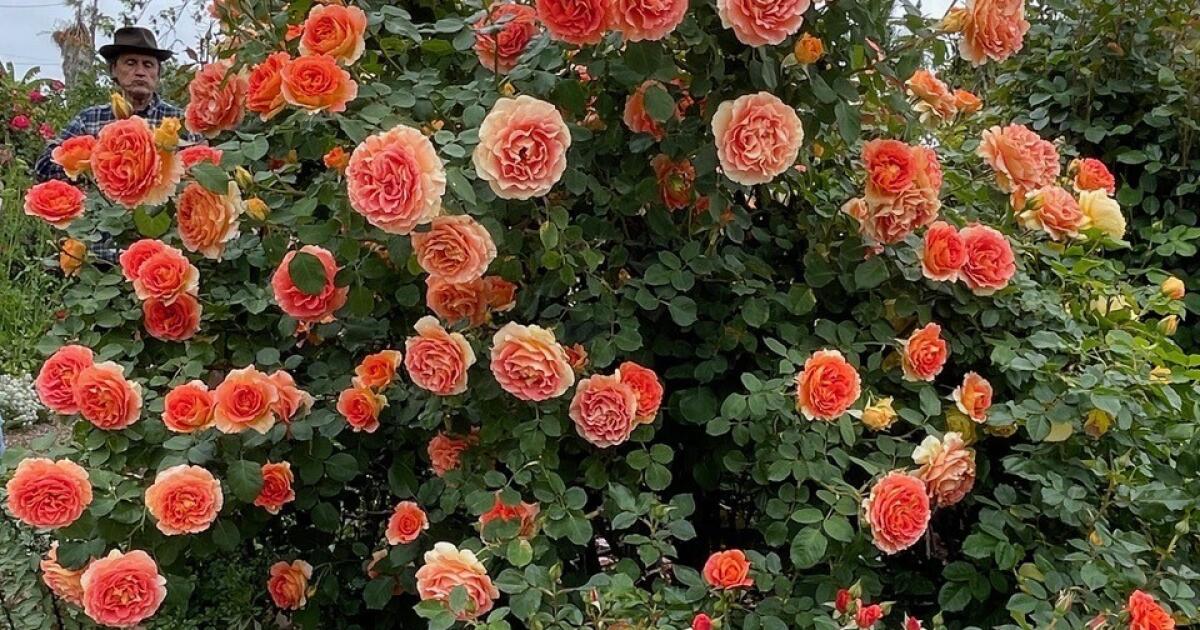
In the heart of every rose gardener is the conviction that next year’s rose garden holds the promise of being the very best ever. To this end, as the present year draws to a close, we research and seek out new roses to plant. But before we buy, we need to do lots of planning and location, location, location is where we should get started.
“Location, location, location.” This is a top consideration for buyers of real estate. It should be equally important for rosarians. Whereas in real estate the triple repetition of the word emphasizes the importance of a desirable location, with roses each use of the word connotes separate, distinct and all-important crucial factors.
The importance of location in the rose garden
1. Regionality: Not all roses perform equally well in every region of the country.
2. Placement: The right rose must be planted in the right place in the garden.
3. Soil: Consideration of what soil to use in parts of our garden may impact rose performance.
Regionality
“Selecting the right rose for your garden makes all the difference.” This is the opening line on the website for American Garden Rose Selections (AGRS). And it is true! First, because roses are not all equal in disease resistance, and second, because very few rose varieties grow equally well in all parts of the country. AGRS conducts trials, tests and evaluates roses for two years in six geographical regions in the United States. Check the website for recommended roses for our Southwest region. Also, visit local gardens and ask the San Diego Rose Society which roses perform best in San Diego.
Placement
The right rose in the right place will bring you a lot of happiness. Before you buy a rose, determine whether your garden space is appropriate.

The right rose in the right place: Floribunda ‘Sunsprite’ is thriving with good sun exposure and soil.
(Rita Perwich)
Sun: Roses need at least five to six hours of sun each day. We create a setting for plant stress when we plant our sun-loving roses in the shade or under or too close to a tree. This type of stress is called abiotic stress, and an abiotically stressed plant will be more susceptible to fungal diseases and pests. In addition, roses planted in the shade will not bloom as much.
Garden design: Before you go to the nursery, look at your garden space and measure the dimensions of the sunny area where you are considering planting a rose. Think about where your garden could use height, color or fragrance to greatest effect. Is your garden calling for the vertical drama of a climber? Perhaps it needs a showy hybrid tea, or a shrub or floribunda for lots of garden color? How about a strongly fragrant rose planted close to your favorite outdoor chair?

Before you go to the nursery, look at your garden space. Think about where your garden could use color or fragrance to greatest effect.
(Rita Perwich)
Spacing: Now research how large the rose you are considering will be at maturity. It is so tempting when we are out of space to plant roses too close together. Overcrowded roses are challenged: Competition for sun, water and nutrients can make them more susceptible to disease, and when air circulation is hampered, fungal dissemination becomes easier and more efficient. Generally, hybrid teas are spaced 30 to 36 inches apart from center to center. Floribundas can be spaced more closely. Shrub roses vary hugely in size, so space them based on their size at maturity.
Soil factors
Healthy productive roses need a healthy, porous, organically rich soil that drains well and is mulched to retain water. A good soil encourages deep growth of the anchor roots and ample food, air and water for our roses’ feeder roots.
When soil is not quite right
Poor-draining soil and the “bathtub” effect: Rose roots need oxygen, so avoid compacting the soil by stepping in rose beds. In poor-draining clay soils plant roses in raised beds or in containers.

‘Gertrude Jekyll’ roses were planted on either side of this arch on the same day. No rose had ever been planted on the side with the vigorous 10-foot growth. The rose on the other side is barely 4 feet tall because of rose replant disease.
(Rita Perwich)
An incorrect pH: This prevents our plants from properly taking nutrients from even a nutrient-rich soil. Soil pH is defined as the acidity or alkalinity of the soil. Generally, soils in the western part of the U.S. are alkaline. The correct pH level of our garden soil makes a huge difference to the health of our plants. The ideal pH for roses is a soil that tests between 6.0 and 6.5. When the pH level is higher than 7.5, many plants will struggle to get enough phosphorus, iron and manganese. In addition to a tendency toward an alkaline pH, our San Diego soils may have the additional challenge of high salinity resulting from our irrigation water. The overuse of chemical fertilizers just compounds this problem. A soil test can provide information on our soil’s pH, salinity and the level of essential plant nutrients and fertility. A soil lab usually provides recommendations for soil improvement.
Rose replant disease (RRD): Controversy abounds on the topic of RRD. Fortunate rosarians who have not experienced it in their gardens may believe it is folklore or an “old acorn.” But for those rosarians who have experienced it in their gardens, there isn’t a shadow of a doubt that this phenomenon truly exists in some soils.

The pink ‘Beverly’ rose is only 18 inches tall because of rose replant disease.
(Rita Perwich)
RRD is when new roses do poorly and struggle to establish as well as they would if they were grown in soil never previously planted with roses. This scenario occurs even when the soil in the hole is amended. When the rose is removed, another species of plant can grow well in the planting hole. The phenomenon is not isolated to roses. Many plants — including tomatoes, apples, pears, plums and cherries — planted in soil previously occupied by members of a related species suffer decline and sometimes even die. Two microorganisms, nematodes and Actinomycetes, are being investigated as possible causes in European control studies.
In smaller gardens, we have limited alternate spots to grow roses, so RRD can pose a real dilemma. I have seen my roses go from declining to delightful with the following tactics:
Alternative rootstocks: Some plant varieties and rootstocks have better resistance to nematodes. Florida has a big nematode problem, so roses are grafted on nematode-resistant Fortuniana rootstock. We can order roses grafted on Fortuniana rootstock online from K & M Nursery. In my garden, I have two Savannah roses. Each rose is planted in a hole previously occupied by another rose. The Savannah rose that is grafted on Fortuniana root stock is almost 6 feet tall. The own root Savannah rose is about 1 foot tall and is earmarked to be shovel pruned.
Meticulously remove all its roots when you dig out a rose: Replace the old soil in the hole with fresh soil from another part of the garden where roses have not been grown. Add organic matter such as compost and worm castings to the hole. Try your best to position the new planting hole at least a foot away from the original planting hole.

‘Beverly’ grown in a garden where rose replant disease is not an issue is 4 to 5 feet tall.
(Rita Perwich)
Failure to thrive? Give it a second chance! I have dug out roses from the garden and watched them recover strength and vigor by washing all the soil from their roots and either planting them in potting soil in a container or transplanting them into a spot never previously planted with roses.
Planting a bare root rose: First plant it in a container and transplant it into the “sanitized” hole only when it has developed a solid rootball in hopes that a healthy, well-established plant might be better able to withstand RRD. Evaluating whether a rose is a keeper before transplanting it into the ground will minimize the number of times you have to deal with replant issues.
Fortunately, we rosarians are good at puzzles. Once our rose imagination is stirred, we always manage to find a way and a solution to welcome the right rose to the right location in our garden.
Perwich is a member of the San Diego Rose Society, a consulting rosarian and a master gardener with UC Cooperative Extension.







